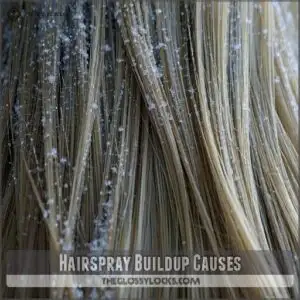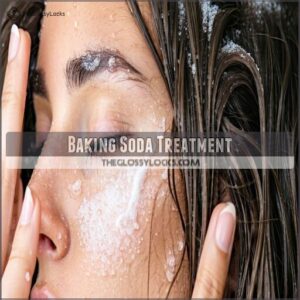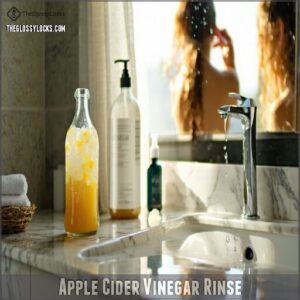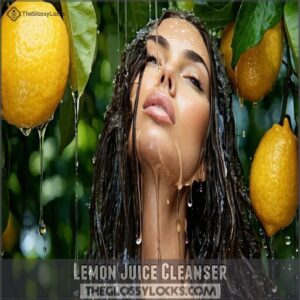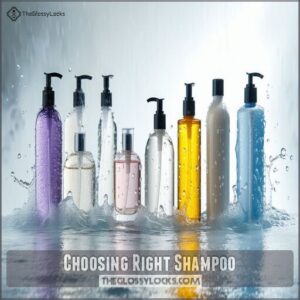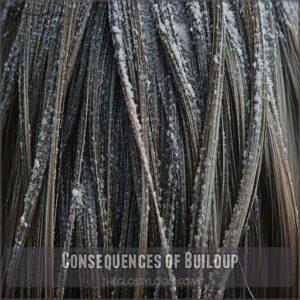This site is supported by our readers. We may earn a commission, at no cost to you, if you purchase through links.
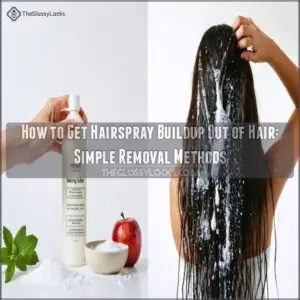 To tackle hairspray buildup, start with a clarifying shampoo—it’s like a reset button for your hair.
To tackle hairspray buildup, start with a clarifying shampoo—it’s like a reset button for your hair.
Massage it in thoroughly, rinse, and repeat if needed. For a natural fix, mix a teaspoon of baking soda with your shampoo or rinse with diluted apple cider vinegar (don’t worry, the smell fades).
These cut through residue like a pro. Avoid scrubbing too hard; your scalp isn’t a kitchen floor.
Follow up with a moisturizing conditioner to keep your strands happy. Want to avoid buildup altogether? Rotate products and wash regularly.
Curious about other tricks? There’s more where that came from, to help you master a reset button for your hair and find a good natural fix.
Table Of Contents
- Key Takeaways
- Hairspray Buildup Causes
- Remove Hairspray Buildup
- Natural Removal Methods
- Choosing Right Shampoo
- Preventing Buildup
- Consequences of Buildup
- Frequently Asked Questions (FAQs)
- How do I remove hairspray residue from my hair?
- How do you fix damaged hair from hairspray?
- What does hairspray buildup on hair look like?
- Can hairspray buildup cause scalp infections?
- How does buildup affect hair dye longevity?
- Are there signs of buildup on curly hair?
- Does hairspray buildup impact hair extensions?
- Can buildup lead to itchy scalp conditions?
- Conclusion
Key Takeaways
- Use a clarifying shampoo weekly to cut through hairspray buildup and restore your hair’s shine.
- Try natural remedies like baking soda mixed with shampoo or an apple cider vinegar rinse for a DIY deep clean.
- Rotate your hair products and avoid overusing hairspray to prevent residue from building up.
- Keep your scalp healthy by washing regularly, exfoliating, and avoiding harsh scrubbing.
Hairspray Buildup Causes
Hairspray buildup happens when too much product, sweat, or even hard water sticks to your hair over time.
Too much hairspray can weigh down your hair, leaving it dull, heavy, and harder to manage over time.
It leaves your strands feeling heavy, dull, and harder to manage, no matter how often you wash.
Excessive Hairspray Use
Using hairspray too often can leave your hair feeling like it’s carrying extra baggage.
Frequent application, especially with strong holding power formulas, leads to stubborn residue. Improper technique, like spraying too close, worsens buildup.
To remove hairspray residue, try a clarifying shampoo weekly. Reducing application frequency and choosing lighter formulas can help prevent hair product buildup and keep your locks fresh.
Heavy Styling Products
Hair styling products like gels, mousses, and waxes can cling to your strands, creating stubborn buildup over time.
Poor application techniques, such as over-layering, worsen the issue.
To maintain scalp health, switch to lightweight product alternatives and use a clarifying shampoo weekly.
This deep clean hair routine prevents long-term effects like dullness and guarantees effective hairspray buildup removal.
Hard Water Minerals
Mineral deposits from hard water can stick to your hair, making hairspray buildup removal even trickier.
These pesky hardness levels affect scalp health and worsen hair product buildup.
A water softener or chelation therapy helps reduce buildup.
For hair cleansing, use a clarifying shampoo weekly to combat residue. It’s like giving your hair a fresh start!
Sweat and Pollution
Sweat and pollution sneak into your hair like uninvited guests, contributing to scalp buildup and dull strands.
Environmental exposure mixes with hairspray buildup, making hair cleansing a challenge.
To combat this:
- Use protective hairstyles to minimize hair pollution particles.
- Wash regularly for effective product buildup and scalp buildup removal.
- Opt for clarifying shampoos to guarantee deep hairspray buildup removal.
Regular washing helps to promote scalp health by removing buildup, which is essential for maintaining healthy hair and preventing scalp issues.
Remove Hairspray Buildup
Getting rid of hairspray buildup doesn’t have to feel like climbing a mountain. Start with a clarifying shampoo—it’s like a reset button for your hair.
Start fresh with a clarifying shampoo—it’s your hair’s ultimate reset button for tackling stubborn buildup and restoring shine.
If you’re dealing with stubborn residue, try mixing baking soda with your regular shampoo for a DIY hairspray detox. For greasy strands, a tiny drop of dish soap can work wonders, but skip it if your hair’s color-treated.
And don’t forget about tool cleaning—your brushes and combs might be sneaky culprits adding to the buildup effects. For a gentler approach, consider micellar water application to lift oil-based residues.
Professional treatments are also an option if home remedies don’t cut it. Bonus tip? A sea breeze-inspired rinse with apple cider vinegar diluted in water can leave your hair refreshed and shiny.
| Method | Ingredients Needed | Time Required | Best For |
|---|---|---|---|
| Clarifying Shampoo | Store-bought shampoo | 5 minutes | General buildup removal |
| Baking Soda Mix | Baking soda, shampoo | 15 minutes | Stubborn residue |
| Dish Soap | Mild dish soap | 15 minutes | Oily hair, heavy buildup |
| Vinegar Rinse | Apple cider vinegar | 10 minutes | Shine and detoxification |
Natural Removal Methods
You don’t need fancy products to tackle hairspray buildup—simple, natural solutions can do the trick.
With a few common household items, you can restore your hair’s shine and health in no time.
Baking Soda Treatment
Baking soda’s versatility makes it a lifesaver for stubborn hairspray buildup.
Try these DIY clarifying treatments:
- Mix 2 tbsp. shampoo with 1 tsp. baking soda, apply, and rinse thoroughly.
- Massage baking soda directly onto wet hair for a quick cleanse.
- Create a paste with 3 parts baking soda, 1 part water, and apply.
Use baking soda alternatives like clarifying shampoo for your hair cleansing routine. You can find a baking soda shampoo product online, which is a great alternative to traditional methods.
Apple Cider Vinegar Rinse
An apple cider vinegar rinse is a game-changer for tackling hairspray residue.
Dilute ACV (5 parts water to 1 part vinegar) and use it weekly for shine enhancement and scalp pH balance.
It breaks down hair product buildup effortlessly.
You can find various ACV products online.
Here’s a quick breakdown:
| Step | Action | Frequency | Benefit |
|---|---|---|---|
| Dilution | Mix ACV with water | Every rinse | Gentle on scalp |
| Application | Pour over hair | Weekly | Removes buildup |
| Rest Period | Leave for 5 minutes | Per use | Boosts shine |
| Rinse Out | Wash thoroughly with water | Per use | Refreshes hair care |
Try it for a fresh hair cleansing routine and experience the benefits of apple cider vinegar for yourself, with a weekly application to keep your hair healthy and strong.
Aloe Vera Gel Application
Following an apple cider vinegar rinse, try aloe vera gel for tackling hair residue.
Its lightweight Gel Recipe blends aloe benefits with lemon synergy and rosemary infusion to regulate sebum and break down buildup.
Apply this soothing mix to your scalp and hair, leave it for 30 minutes, then rinse.
It’s hair care magic—hydrating, rejuvenating, and promoting hair health.
Lemon Juice Cleanser
Lemon juice is a natural cleansing powerhouse for tackling hair product buildup.
Massage it directly onto your scalp to break down stubborn hair residue. This scalp massage both cleanses and boosts shine enhancement.
Afterward, rinse thoroughly to avoid stickiness. It’s a simple, effective hair cleansing trick that leaves your locks refreshed and free from buildup—no fancy products needed, making it a great way to achieve natural cleansing and hair product buildup removal.
Choosing Right Shampoo
Choosing the right shampoo is key to tackling hairspray buildup effectively. You’ll want one that cleans thoroughly without stripping your hair of its natural oils.
Clarifying Shampoos
If natural remedies aren’t cutting it, clarifying shampoos are your go-to for hairspray residue on hair.
They’re like a reset button for hair product buildup. Consider clarifying shampoo hairspray for stubborn buildup.
Look for formulas suited to your needs:
- Ingredients Explained: Seek chelating agents and tea tree oil for deep cleaning.
- Frequency Guide: Use weekly for oily hair, monthly for thicker textures.
- DIY Alternatives: Baking soda mixes boost effectiveness.
Sulfate-Free Shampoos
Sulfate-free shampoos are your go-to for gentle cleansing without stripping natural oils.
They’re color-safe and perfect for maintaining hydration balance while tackling product buildup.
Look for natural ingredients that promote scalp health.
These shampoos work wonders for hair care, especially if you’re sensitive to harsh chemicals.
Think of them as a clarifying shampoo’s kinder, gentler cousin.
| Feature | Benefit | Ideal For |
|---|---|---|
| Gentle Cleansing | Prevents dryness | Sensitive scalps |
| Color Safe | Protects dyed hair | Color-treated hair |
| Natural Ingredients | Nourishes and soothes | Healthier scalp care |
Moisturizing Shampoos
Moisturizing shampoos offer a hydration boost, perfect for tackling dryness caused by hairspray buildup.
Look for ingredients like aloe vera or glycerin to restore scalp health and soften strands.
Pair them with a sulfate-free clarifying shampoo to remove product buildup while keeping moisture intact.
If you prefer DIY recipes, try adding a splash of honey for extra nourishment and shine.
For enhanced hydration, consider shampoos with raw shea butter.
Preventing Buildup
You can prevent hairspray buildup by using lighter products and washing your hair regularly with the right shampoo.
Rotating your styling products and keeping a balanced diet also helps keep your hair fresh and healthy.
Limit Hairspray Use
Cutting back on hairspray use can save your hair from unnecessary stress.
Reserve it for special occasions or when you need extra hold. Opt for lighter formulas to reduce hairspray buildup and mist from a distance for even coverage.
Alternate products like mousse or creams, and practice product rotation to avoid layering the same ingredients, minimizing hairspray residue.
Regular Washing
Regular washing is your first defense against hairspray buildup.
Stick to a washing frequency that suits your hair type—oily hair may need more frequent care. Use gentle products and a clarifying shampoo weekly for hair buildup removal.
Focus on your scalp with a relaxing scalp massage, and rinse with lukewarm water.
Hot water can dry hair out, so keep it cool!
Rotate Hair Products
Switching up your hair products keeps things fresh and fights hairspray buildup.
Sticking to one product can lead to ingredient layering, making hair dull and lifeless.
Try a personalized product schedule with a mix of lightweight sprays, creams, or gels.
This reduces product reliance and promotes scalp health.
A little variety can go a long way in managing hair product buildup!
Healthy Diet
For healthier hair and less product buildup, focus on what’s on your plate.
A balanced diet boosts nutrient absorption, promoting scalp health and hair strength.
Stay hydrated to maintain ideal hydration levels.
Deficiencies in vitamins like biotin or zinc can weaken hair, making it prone to hairspray buildup.
Think of food as fuel for your hair cleanse and overall hair care routine!
Consequences of Buildup
When hairspray builds up, it doesn’t just sit there—it clogs your scalp and weighs your hair down.
Over time, this can lead to dryness, breakage, and even make your hair look dull and lifeless.
Clogged Scalp Pores
When hairspray buildup clogs your scalp pores, it’s like blocking a highway—nothing flows right.
Excess residue traps oil, or sebum, disrupting follicle health and making your hair look greasy.
Regular scalp exfoliation can help clear product buildup and restore balance, keeping pores clean as well as improves scalp health but also supports healthy hair follicles and better sebum production.
Hair Dryness and Breakage
Dry hair buildup from hairspray can zap your hair’s elasticity, leaving it brittle and prone to breakage.
Think of split ends as tiny flags waving for hydration importance! Product buildup and protein deficiency worsen hair damage, making strands snap easily.
Avoid heat damage by deep conditioning regularly and using clarifying shampoos to tackle hairspray buildup. Nutritional deficiencies impact hair strength, requiring a balanced diet.
Healthy hair starts with proper care, not shortcuts, emphasizing the need for proper care.
Acne and Hair Loss
Your scalp isn’t just a victim of hairspray buildup—it’s ground zero for issues like Scalp Folliculitis and acne.
Clogged hair follicles from hair product buildup can trigger inflammation effects, worsening hair loss.
Over time, buildup severity weakens strands, amplifying DHT impact and thinning hair.
Treatment options? Regular clarifying shampoos and proper cleansing routines can rescue your scalp and hair health.
Dull and Lifeless Hair
When product buildup clogs your hair, it can look dull and lifeless, like it’s given up on its dreams. Hairspray buildup steals shine, volume, and texture, leaving strands thirsty for hydration.
To combat hair dullness and breakage, try these:
- Use a clarifying hair mask weekly.
- Rinse with apple cider vinegar.
- Switch to lightweight products.
- Deep condition regularly.
- Avoid over-styling.
Frequently Asked Questions (FAQs)
How do I remove hairspray residue from my hair?
When your locks feel like they’ve been through a glue factory, mix baking soda with shampoo or use apple cider vinegar diluted in water.
These simple fixes cut through residue, leaving your hair fresh and light.
How do you fix damaged hair from hairspray?
To fix damaged hair from hairspray, deep condition weekly to restore moisture.
Trim split ends, avoid heat styling, and use nourishing oils like argan or coconut.
Switch to lightweight products and give your hair a break!
What does hairspray buildup on hair look like?
Hairspray buildup makes your hair look greasy, dull, and flat, no matter how much you wash it.
It can feel sticky or stiff to the touch, and styling becomes a frustrating uphill battle.
Can hairspray buildup cause scalp infections?
Think of your scalp like a garden—hairspray buildup can clog "soil" (pores), trapping dirt and bacteria.
This creates a breeding ground for infections, irritation, or even folliculitis.
Keep it clean to avoid these issues!
How does buildup affect hair dye longevity?
Buildup can block hair dye from penetrating evenly, making your color fade faster or look patchy.
It’s like painting on a dusty surface—clean hair guarantees vibrant, long-lasting results without frustrating touch-ups.
Are there signs of buildup on curly hair?
Like a sweater that’s too tight, curly hair with buildup feels heavy, limp, and loses its bounce.
You’ll notice dull strands, greasy roots, flaky residue, and curls that refuse to hold their shape, which can be described as having dull strands.
Does hairspray buildup impact hair extensions?
Yes, buildup can damage hair extensions by weighing them down, making them look dull and lifeless.
It also weakens bonds or tapes, causing slippage.
Regular clarifying treatments keep your extensions clean and looking fabulous.
Can buildup lead to itchy scalp conditions?
An ounce of prevention is worth a pound of cure.
Product buildup can clog follicles, irritate your scalp, and mimic dandruff.
Itchy conditions often result when residue traps oils, sweat, and dirt—time for a deep clean!
Conclusion
Dealing with hairspray buildup might feel like battling cement, but it’s easier than you think.
Use clarifying shampoos or natural remedies like baking soda or apple cider vinegar to break down residue.
Rotate your products, wash regularly, and don’t overdo the hairspray.
Your hair will thank you with softness and shine.
Remember, buildup doesn’t just dull your hair—it can lead to dryness and breakage.
Stay consistent, and you’ll keep your hair healthy and buildup-free!

